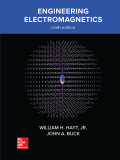
Concept explainers
(a) Determine s on the transmission line of Figure 10.32. Note that the dielectric is air. (b) Find the input impedance. (c) If

Figure 10.32 See Problem 10.20.
(a)
The value ofs on the transmission line.
Answer to Problem 10.20P
The value of son the transmission line is 2.
Explanation of Solution
Given:
The given figure is shown below.

Concept Used:
The term s is calculated by
Calculation:
The reflection coefficient is
The magnitude of the reflection coefficient is,
The standing wave ratio is calculated as
Conclusion:
The value of s in the transmission line is 2.
(b)
The input impedance.
Answer to Problem 10.20P
The input impedance of the transmission line is
Explanation of Solution
Given:
The given figure is shown below.

Concept Used:
The input impedance is calculated by
Calculation:
The input impedance of the transmission line is calculated as
Let
Conclusion:
The input impedance of the transmission line is
(c)
The source current
Answer to Problem 10.20P
The source current is
Explanation of Solution
Given:

Calculation:
The source current is calculated by
Let
Conclusion:
Thus, the source current is
(d)
The value of L which produces maximum value for
Answer to Problem 10.20P
The value of L which produces maximum value for
Explanation of Solution
Given:
The given circuit is shown below.

Concept Used:
The maximum value of L is calculated by
Calculation:
The magnitude of the source current is,
Differentiating with respect to L,
Conclusion:
The value of L which produces maximum value for
(e)
The average power delivered by the source.
Answer to Problem 10.20P
The average power delivered by the source is,
Explanation of Solution
Given:
The given circuit is shown below.

Concept Used:
The average power is calculated by
Calculation:
Considering the real part only
Average power is calculated as
Conclusion:
Thus, the average power delivered by the source is,
(f)
Average power delivered to ZL.
Answer to Problem 10.20P
The average power delivered to the load is
Explanation of Solution
Given:

Concept Used:
The average power delivered is calculated by
Calculation:
Thus, the total power delivered to the load is
Conclusion:
Thus, the average power delivered to the load is
Want to see more full solutions like this?
Chapter 10 Solutions
Engineering Electromagnetics
- 2. a) Find the Fourier transform of the signal shown in Fig. 2 and express it in its most compact form; b) Find the value of the energy spectral density at f=1/4. 0 -2 -1 -3. Fig. 1 g(t) 3 1 2 t- Fig 2arrow_forward5. Consider a filter whose transfer function is: H(f) = -12xfß (a + jπ f ) ² (a) show that the filter is non-causal for α = 3, p= -1; (b) choose alternate values of α, ẞ that result in a causal filter, and demonstrate that your choice valid.arrow_forward1. Referring to the signals shown in Fig. 1: a) Find the signal energy of x(t). 6 b) Find the signal energy of y(t) . c) Find the signal energy of x(t)+y(t) . d) Are x(t) and y(t) orthogonal? Explain how you can tell. x(t) 0 2 4 y(1) 2 0 2 4 -6 Fig. 1 1-arrow_forward
- Please can you solve this question correctly in a step by step form to help understanding, please make it clear.arrow_forwardPlease can you solve this question in a step by step form correctly, please look at the refernces provided on the data path control lines, the GPLB functions, the processor instruction setarrow_forwardPlease can you solve this question in a step by step form correctly, please look at the refernces provided on the data path control lines, the GPLB functions, the processor instruction setarrow_forward
- Please can you solve this question in a step by step form correctly, please look at the refernces provided on the data path control lines, the GPLB functions, the processor instruction set and using the PLA personality chart.arrow_forwardPlease can you solve this question correctly in a step by step form to help understanding, please make it clear.arrow_forwardI just want to know what is PPE and Give examples of itarrow_forward
- Why is a starting resistor needed to bring a motor up to speed? Show one way to reverse the direction of ro- tation of a compound motor.arrow_forward8- is flip-flop which indicates some condition which arises after the execution of an arithmetic or logic instruction. a) Status flag b) Instruction registers c) Temporary register d) None of these 9- El instruction is a_ a) Branching Instructions b) Logical Instructions c) Control Instructions d) Data Transfer Instruction e) Arithmetic Instructionsarrow_forward1. Write a program to add 4 hex numbers located in the memory locations 2001h, 2002h, 2003h, 2004h and store the result at location 2005harrow_forward
 Introductory Circuit Analysis (13th Edition)Electrical EngineeringISBN:9780133923605Author:Robert L. BoylestadPublisher:PEARSON
Introductory Circuit Analysis (13th Edition)Electrical EngineeringISBN:9780133923605Author:Robert L. BoylestadPublisher:PEARSON Delmar's Standard Textbook Of ElectricityElectrical EngineeringISBN:9781337900348Author:Stephen L. HermanPublisher:Cengage Learning
Delmar's Standard Textbook Of ElectricityElectrical EngineeringISBN:9781337900348Author:Stephen L. HermanPublisher:Cengage Learning Programmable Logic ControllersElectrical EngineeringISBN:9780073373843Author:Frank D. PetruzellaPublisher:McGraw-Hill Education
Programmable Logic ControllersElectrical EngineeringISBN:9780073373843Author:Frank D. PetruzellaPublisher:McGraw-Hill Education Fundamentals of Electric CircuitsElectrical EngineeringISBN:9780078028229Author:Charles K Alexander, Matthew SadikuPublisher:McGraw-Hill Education
Fundamentals of Electric CircuitsElectrical EngineeringISBN:9780078028229Author:Charles K Alexander, Matthew SadikuPublisher:McGraw-Hill Education Electric Circuits. (11th Edition)Electrical EngineeringISBN:9780134746968Author:James W. Nilsson, Susan RiedelPublisher:PEARSON
Electric Circuits. (11th Edition)Electrical EngineeringISBN:9780134746968Author:James W. Nilsson, Susan RiedelPublisher:PEARSON Engineering ElectromagneticsElectrical EngineeringISBN:9780078028151Author:Hayt, William H. (william Hart), Jr, BUCK, John A.Publisher:Mcgraw-hill Education,
Engineering ElectromagneticsElectrical EngineeringISBN:9780078028151Author:Hayt, William H. (william Hart), Jr, BUCK, John A.Publisher:Mcgraw-hill Education,





